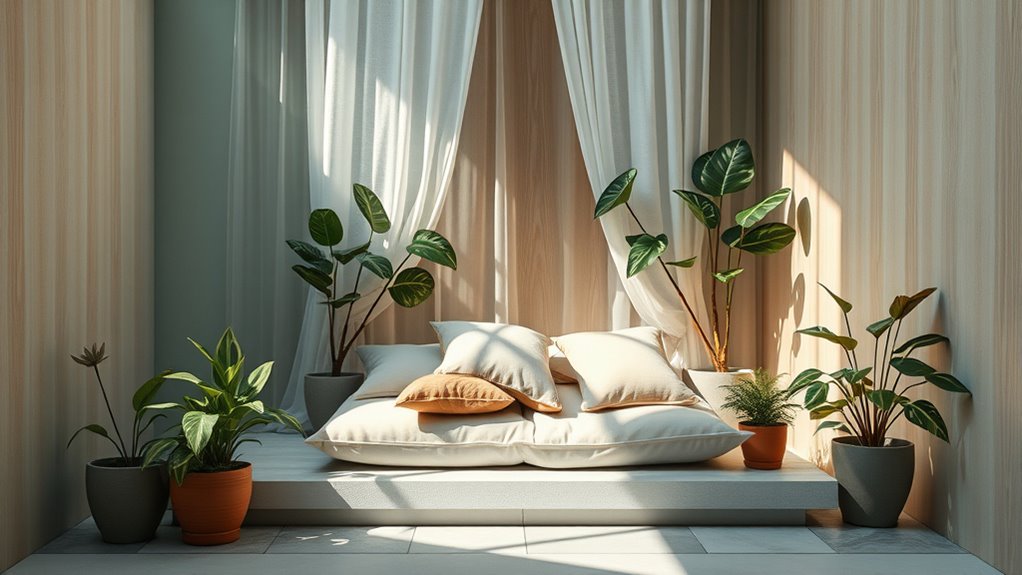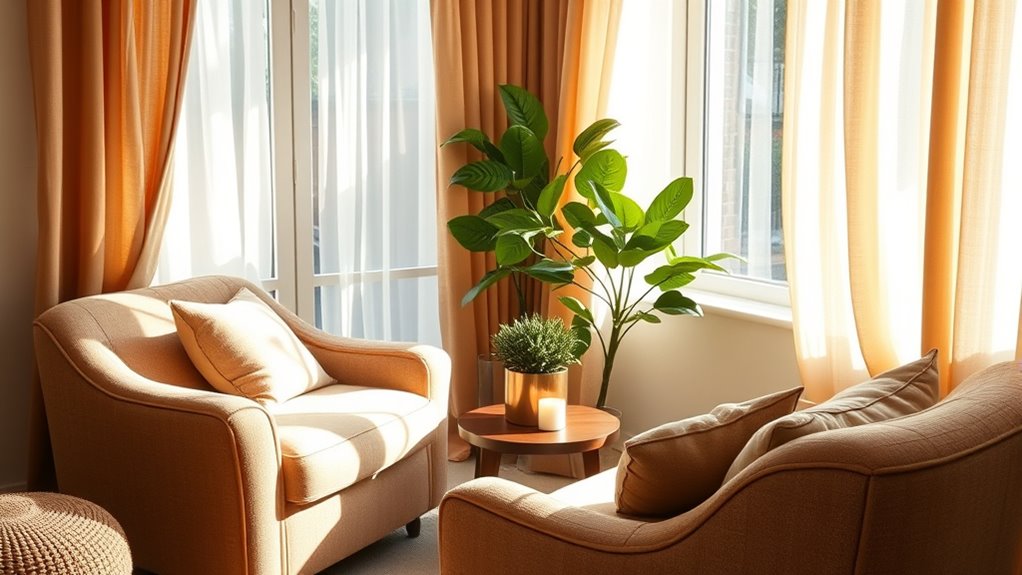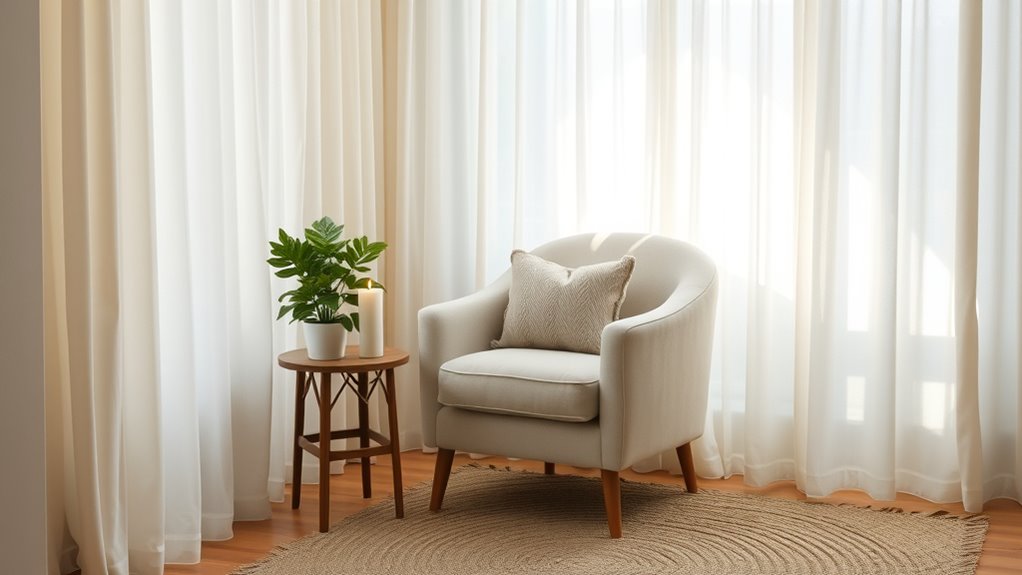To design a device-free rest space, choose a quiet, clutter-free area with natural light and calming colors like blues or greens. Use natural materials and comfy furniture to create an inviting atmosphere. Add soothing sounds, gentle lighting, and calming scents such as lavender. Set boundaries and routines, like scheduled disconnect times and mindfulness practices, to enhance focus on relaxation. Keep exploring ways to transform your space into a true sanctuary for peaceful recovery.
Key Takeaways
- Choose a quiet, clutter-free area with natural light and soundproofing to promote relaxation.
- Use calming colors and natural materials to create a soothing, inviting atmosphere.
- Incorporate comfortable, ergonomic furniture and soft lighting to enhance coziness.
- Add calming elements like gentle sounds, aromatherapy, and minimal distractions.
- Establish routines and boundaries, such as designated times and signals, to reinforce device-free relaxation.
Choosing a Peaceful Location and Layout

Selecting the right location and layout is essential for creating a truly restful space. Start by choosing a quiet area away from noise and distractions, implementing soundproofing techniques like heavy curtains, rugs, or acoustic panels to minimize sound disturbances. Pay attention to the layout by arranging furniture to promote relaxation; for example, position a comfortable chair or bed near a window with soft, natural light. Incorporate ambient lighting options such as dimmable lamps or warm-colored bulbs to create a soothing atmosphere. Keep the space free of clutter to enhance tranquility and focus on comfort. The goal is to craft a sanctuary where sound and light are controlled, allowing you to unwind fully and disconnect from digital distractions. Embracing a creative practice within this space can also foster relaxation and mental clarity.
Selecting Calming Colors and Natural Materials

Creating a restful environment isn’t just about the layout; the choice of colors and materials plays a pivotal role in fostering calm. Color psychology shows that soft, muted tones like blues, greens, and earth tones promote relaxation and reduce stress. Natural materials, such as bamboo, reclaimed wood, or organic cotton, enhance your space’s tranquility while supporting material sustainability. These eco-friendly choices not only create a soothing atmosphere but also reduce environmental impact. Avoid bright, harsh colors or synthetic materials, which can be overstimulating or less sustainable. Instead, opt for calming shades and natural textures that evoke serenity and harmony. Incorporating calming color schemes and natural textures can significantly influence your mood and mental clarity. When you select these elements carefully, you’ll craft a space that naturally encourages rest and mental clarity.
Incorporating Comfortable and Inviting Furniture

To make your rest space truly inviting, focus on incorporating furniture that feels comfortable and encourages relaxation. Use ergonomic cushions to support your body and reduce strain, making it easier to unwind. Opt for soft chairs or loungers with plush upholstery to create a cozy atmosphere. Ambient lighting enhances the mood, providing gentle illumination without harshness. Select furniture that invites you to sit, lounge, or stretch out comfortably. To help you choose, here’s a quick guide:
| Furniture Type | Key Features |
|---|---|
| Lounge Chair | Ergonomic cushions, soft fabric |
| Floor Mattress/Pad | Supportive, plush, easy to move |
| Small Side Tables | Convenient for drinks or books |
| Ottoman/Footstool | Comfortable, versatile seating |
Additionally, incorporating well-designed training guides can help you create a more relaxing environment by establishing routines that reduce stress and promote comfort.
Adding Soothing Elements and Minimal Distractions

Building on the cozy furniture setup, adding soothing elements and minimizing distractions can markedly enhance your rest space. Incorporate ambient sounds, like gentle nature noises or soft music, to create a calming atmosphere that helps you relax. Using sound effects such as rainfall or gentle wind sounds can deepen the sense of tranquility. Aromatherapy diffusers are also effective; they fill the room with calming scents such as lavender or chamomile, promoting tranquility. Keep distractions to a minimum by choosing a quiet, clutter-free area and avoiding visual chaos. Soft lighting, like warm lamps or candles, complements these elements, making the space more inviting. Focus on simplicity and sensory comfort, ensuring every element works together to foster peace. This careful combination of soothing sounds, scents, and minimal visual stimuli helps you unwind deeply and fully disconnect.
Establishing Boundaries and Daily Routines

Establishing clear boundaries and consistent daily routines is essential for transforming your rest space into a true sanctuary. Set specific times when you disconnect from devices to promote a digital detox, helping your mind relax and reducing distractions. Communicate these boundaries to others so your rest space remains undisturbed. Incorporate mindfulness practices into your daily routine, such as meditation or deep breathing, to reinforce a sense of calm and presence. Create rituals that signal the start and end of your rest period, like lighting a candle or playing soothing music. By sticking to these routines and boundaries, you train your mind to associate your space with relaxation, making it easier to unwind and fully disconnect from digital devices. Additionally, understanding the importance of color temperature adjustments can help create an optimal viewing environment that promotes relaxation and reduces eye strain during your rest periods.
Frequently Asked Questions
How Can I Personalize My Device-Free Rest Space Effectively?
To personalize your device-free rest space effectively, focus on incorporating mindful decor that reflects your personality and promotes relaxation. Add sensory elements like calming scents, soft textures, or gentle lighting to create a soothing environment. Choose colors and decor that resonate with you, making the space inviting and unique. By blending mindful decor with sensory elements, you craft a personalized retreat where you can unwind and recharge without distractions.
What Budget Considerations Should I Keep in Mind?
Imagine transforming your rest space into a serene retreat without emptying your wallet. You should focus on cost-effective solutions like repurposing furniture and using budget-friendly materials such as natural fabrics and simple decor. Prioritize essentials and avoid extravagant expenses. Keep an eye on your budget by researching affordable options, and remember, creating a peaceful sanctuary doesn’t mean spending a fortune—smart choices make all the difference.
How Do I Maintain Privacy in a Shared Home?
In a shared home, you can maintain privacy by setting clear boundaries and respecting privacy concerns. Use shared space etiquette, like knocking before entering and using screens or curtains to create personal zones. Communicate openly with housemates about your needs, and consider physical barriers or designated areas for privacy. These steps help foster mutual respect, ensuring everyone feels comfortable and secure in the shared environment.
What Are Some Quick Tips for Daily Upkeep?
A stitch in time saves nine, so keep your space inviting daily. Use decorative lighting to create a calming atmosphere and change up scent selection to refresh the vibe. Regularly tidy clutter, wipe surfaces, and fluff cushions to maintain a cozy environment. These quick tips help you sustain a peaceful, device-free rest space, making it easier to unwind and recharge each day without effort.
How Can I Encourage Family Members to Respect the Space?
You can encourage your family to respect the space by practicing respectful communication and clear boundary setting. Explain why the space is important for everyone’s well-being, and kindly ask them to honor it. Consistently reinforce these boundaries and lead by example. When everyone understands the purpose and respects each other’s needs, your device-free rest space becomes a shared sanctuary for relaxation and recharging.
Conclusion
Now that you’ve set up your device-free rest space, imagine the peace it’ll bring—every moment free from screens, every breath more relaxed. But the true magic lies in how you’ll use it daily. Will you embrace the calm and make it a sanctuary? Or let distractions creep back in? The choice is yours, and the potential for true relaxation awaits just beyond the door. Are you ready to open your perfect retreat?









